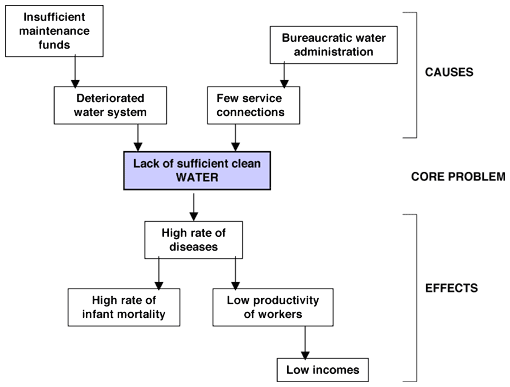|
||||||||||||
Getting Started
|
||||||||||||
|
|
||||||||||||
| ‘Problem Tree’ analysis tool | ||||||||||||
References: |
||||||||||||
|
This tool assists in analyzing an existing situation by identifying the major problems and their main causal relationships. The output is a graphical arrangement of problems differentiated according to ‘causes’ and ‘effects,’ joined by a core, or focal, problem. This technique helps understand the context and interrelationship of problems, and the potential impacts when targeting projects and programs toward specific issues. Use of cards - one problem per card - makes the tool useful for group participation in a workshop setting. The outcome represents the collective thinking of the participants. The technique is an integral part of the ZOPP approach championed by the GTZ and many European development organizations. (See: Tools: ZOPP, and Tools: Logical Planning Framework) The ‘problem tree’ is often followed by an ‘objectives tree.’ The problems are converted through simple rewording into specific objectives, and the chart then shows a ‘means-ends’ relationship. For example, ‘lack of sufficient water’ becomes ‘improve water supply.’ These objectives than provide a basis for project and program definition. Because the ‘problem tree’ is never static and seldom - if ever - the same for different groups and at different times, it is more a device to broaden thinking than as a definitive project determinant. For example, ‘lack of sufficient water’ could either be a ‘cause’ or an ‘effect,’ depending on the situation and participating group, and the project objectives and tasks would be different for each. Steps
|
||||||||||||
|
|
||||||||||||
|
Example of a ‘Problem Tree’ |
||||||||||||
 |
||||||||||||
|
||||||||||||
